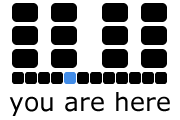Affordances
by Jentery, Curtis, Matthew & Jamie
If this investigation has had a centralizing impulse at all, it has been to construct an analysis of the multiple “constraints and affordances” involved in composing media with metadata in mind. Therefore, each of our different lines of inquiry can be thought of as an attempt to propose very different arguments about what metadata affords—the possibilities and opportunities that are offered by a “Standards in the Making” (SITM) approach to new media. Each of these approaches has located affordances in different and conflicting understandings of metadata’s discursive properties and through a different approach to their constraints as well.
As a starting point, Matt’s breakdown of the “commitments” of an SITM approach offers us a vocabulary that might be used to frame several different readings of metadata’s affordances. In his approach, SITM must be able to “invite cross-readings” and “underscore dissension” while allowing data objects to both “multiply” and “move.” We might all agree that any situation which “allows standards to emerge” must afford dissenting relationships to existing standards (underscoring SITM’s function as a critical practice) while also allowing for “movement” in such a way as to animate different readings and uses of data. But the question of what this “movement” actually entails forms the basis of our own dissenting opinions about metadata’s affordances.
Of course, the question that follows from Matt’s framing is whether or not folksonomies and other social metadata systems actually “afford” such an approach, and his inquiry into the operations of different online, group-authoring platforms insists, not only that software plays a fundamental role in defining the constraints and affordances of metadata, but that the real question is whether the platform in question frames metadata as “situational,” meaning “never truly packagable…and therefore contingent.” This emphasis privileges authoring programs that can manage to highlight the contingency of their own narratives of production—multi-authoring environments like GoogleDocs where the writing in question is only ever temporarily “fixed” in its meaning or governing standards. For Matt, we might say that data is allowed to “move” as a consequence of the “contingency” that is built into its status as an object. But an interesting tension emerges when this approach is compared to Curtis’s, who argues, broadly, that contingency is not granted by the situation of authorship, but produced in the contradictory relationships between different metadata “arguments.” In his analysis of the “Negro Boy” photo, for instance, he argues that we can observe the contingency of racial metadata in the competing categories of “black” and “Negro,” “precisely because they both appropriate the same objects in the name of entirely different uses.” Here, racial metadata, conceived as an “argument” about the nature of racial history, identity, and experience, is “contingent” because the folksonomy allows us to glimpse the multiplicitous and contradictory nature of the readymade standards provided by contemporary cultural formations. Put another way, the tension between Matt’s and Curtis’s understanding of “contingency” may be reduced to the question of whether data objects “move” as a result of the situational boundaries of their authoring environments or because the critical lens of SITM allows us to see all instances of metadata as “arguments” that converse and conflict across folksonomic tagging archives. Either way, the essential question is how and in what way metadata affords an unleashing of the data object from the readymade standards that fix it in certain definitions, proper interpretations, and subsequent “uses.”
The idea that metadata affords “movement” has an entirely different valence if we consider Jentery’s suggestion that SITM affords new modes of writing through research, particularly in “the use of digital technologies to strategically search a large number of documents and mobilize the search results toward new knowledge about literature, culture, history, and society.” While constructing “interoperable” archives that allow for the “harvesting of information across domains” and the ability to sight associations and relationships that are neglected by “more familiar schemas” of organizing data, metadata also affords a “distanced” reading model that is, in Moretti’s terms, “its own specific form of knowledge” (2005, p. 1). SITM, in this case, produces a productive defamiliarization of the scholarly archive and attendant critical practices, allowing for movement across supposedly discrete archives and through a number of different scales of critical analysis. Jamie, also focused on the affordances of metadata (and digital discourse more generally) for writers, floats the suggestion that metadata “might allow us to rethink the relationship between process and product as well as between author and audience” in composition generally and composition instruction more specifically. Together, these perspectives suggest that the new work of composition is in the way that SITM proposes new modes of inquiry and analytic methods, as well as new rhetorical contexts for writers to engage.
